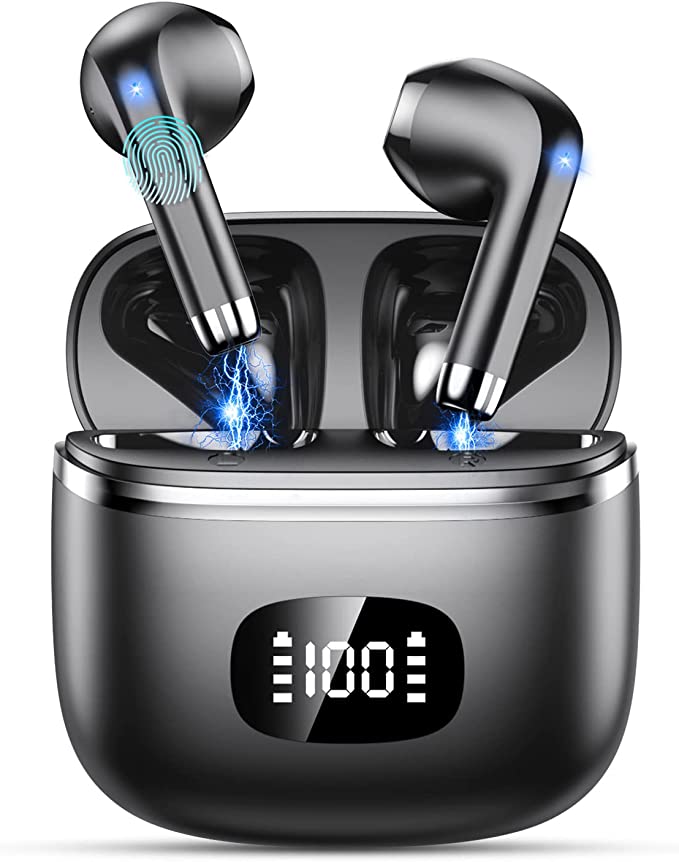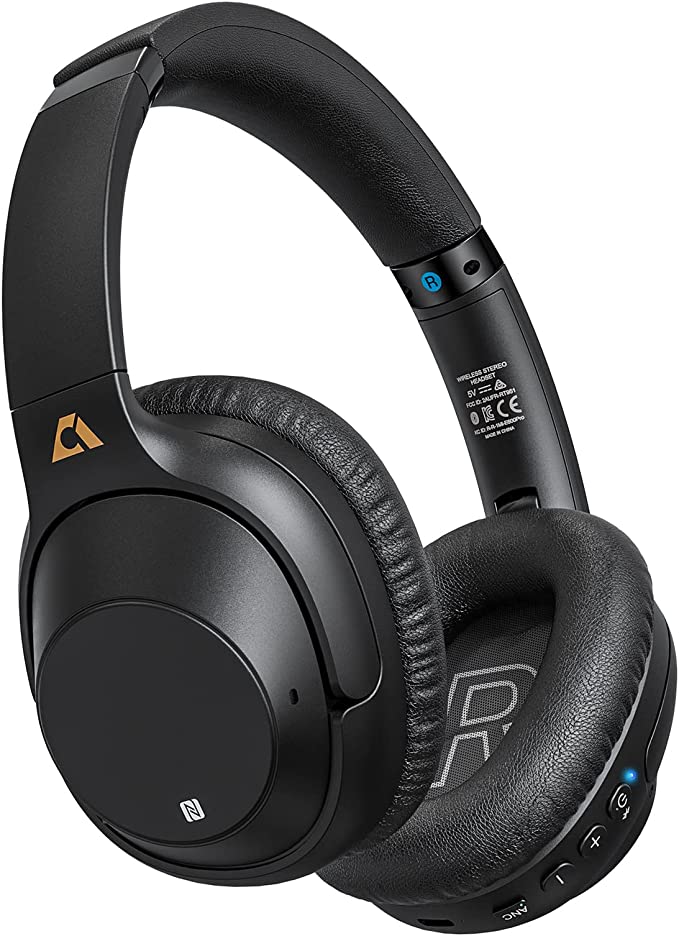We live in a world increasingly untethered. From our phones to our music, the wires that once bound us to devices are rapidly disappearing, replaced by invisible connections that grant us unprecedented freedom. True wireless earbuds have become emblematic of this shift, transforming commutes, workouts, and daily chores into seamless audio experiences. But have you ever paused to wonder about the intricate technology packed into these tiny devices? Let’s take a closer look, using the POMUIC W23 Wireless Earbuds as our case study, to explore the fascinating science and engineering that make this everyday magic possible. We’ll peel back the layers on connectivity, power, sound, durability, and interaction, revealing how these elements work together.

The Heart of the Connection: Untangling Bluetooth 5.3
The lifeline of any wireless earbud is its connection to your device, typically orchestrated by Bluetooth technology. At its core, Bluetooth is a standardized short-range radio communication protocol, allowing devices to talk to each other without physical links. Think of it as a sophisticated, invisible handshake. The POMUIC W23 employs Bluetooth 5.3, a relatively recent iteration of this standard.
So, what does “5.3” signify beyond just a number? Each Bluetooth version aims to improve upon the last. While specific performance can vary based on the chips used and device implementation, Bluetooth 5.3, as defined by the Bluetooth Special Interest Group (SIG), offers potential enhancements geared towards better efficiency and reliability compared to older versions like 4.x or even 5.0/5.1/5.2. The product description for the W23 claims this results in “audio data transfer speeds by up to 75%” faster and allows for “more stable connections and lower power consumption.”
Let’s unpack those claims cautiously. A potential increase in data transfer capability doesn’t always mean your music sounds 75% better, but it can be likened to having a wider data pipe. This extra bandwidth could reduce the likelihood of audio stuttering or dropouts, especially in environments with lots of wireless interference – contributing to that feeling of a “more stable connection.” Furthermore, improved efficiency in how data is transmitted and received (a key focus in later Bluetooth 5.x updates) can indeed lead to “lower power consumption.” This means the earbuds’ tiny batteries might last longer on a single charge, a crucial factor for devices we rely on throughout the day.
From a user’s perspective, Bluetooth 5.3 facilitates convenience features like the “One-Step Pairing” described for the W23. After the initial setup – typically involving selecting the earbuds in your device’s Bluetooth menu – the earbuds are designed to automatically recognize and reconnect to the last paired device when taken out of their charging case (though one user Q&A suggested for the W23, this happens upon placing them in the ear, not just opening the case – a minor workflow difference). And thanks to Bluetooth being a universal standard, these earbuds are designed for broad compatibility, connecting readily with the vast majority of modern smartphones (iOS and Android, including 5G phones as confirmed in the Q&A), tablets, laptops, and other Bluetooth-enabled devices.

Powering the Soundtrack of Your Life: Battery & Endurance
A common anxiety with wireless devices is battery life. How long can these tiny earpieces possibly last? The W23 specifications state up to 7 hours of playback on a single charge for the earbuds themselves. This is a respectable duration for many listening sessions or work blocks. But the real key to their extended usability lies in the companion charging case.
This case isn’t just a protective shell; it’s a portable power bank specifically designed for the earbuds. It houses its own larger battery, capable of recharging the earbuds multiple times on the go. The description claims the combined system delivers up to 40 hours of total playback time before the case itself needs recharging. This significantly reduces charging frequency, making the earbuds practical for multi-day trips or long weeks without easy access to a power outlet.
The energy storage within these devices typically relies on Lithium Polymer (Li-Po) batteries (the W23 listing mentions three are included in the system). Li-Po technology is favored in compact electronics like earbuds because it offers good energy density (storing a decent amount of power for its size and weight) and can be manufactured in flexible shapes to fit constrained spaces.
Keeping track of this power ecosystem is made easier by the LED digital display integrated into the W23’s charging case. This provides a more precise indication of the case’s remaining battery percentage compared to simple indicator dots, helping users know when it’s time to plug the case in. Speaking of plugging in, user feedback indicates the case utilizes a USB Type-C port for charging – a welcome feature aligning with the modern standard used by many phones and laptops, reducing cable clutter. However, potential buyers should note, based on a direct answer in the Q&A section, that the W23 case does not support wireless charging via a charging pad.

Soundscapes and Conversations: Audio Delivery & Calls
Ultimately, earbuds exist to deliver sound. This task falls to the drivers, which are essentially miniature speakers inside each earpiece. The POMUIC W23 features 13.4mm drivers. In speaker design, the driver’s diaphragm vibrates to create sound waves that travel to our ears. While size isn’t the only factor determining sound quality, larger drivers generally have the capacity to move more air, which can contribute to a more robust low-frequency (bass) response. This aligns with the product description’s claim of “Superior Stereo Sound” characterized by “powerful bass, clear mids and bright highs.” Of course, perceived sound quality is highly subjective and influenced by factors like the driver’s materials, the earbud’s acoustic design, the seal in the ear, and the listener’s personal preferences.
Beyond music, wireless earbuds have become essential tools for communication. The W23 includes a built-in microphone for handling calls. The description asserts the earbuds are “designed for calls” and claims they effectively filter out 90% of background noise to improve clarity. This is a bold claim, and without specifics on the technology used (e.g., multi-microphone arrays, AI algorithms), it’s best understood as a manufacturer’s description of intended performance. Basic noise filtering might involve microphone placement designed to focus on the user’s voice or simple electronic filtering. Interestingly, one user review mentioned being told their voice wasn’t “crystal clear” on calls, highlighting that real-world call quality can be variable and might not always match bold filtering claims, especially in more budget-friendly models.

Built for the Everyday Hustle: Durability & Fit
Life isn’t always lived in pristine conditions. Earbuds face challenges from sweat during workouts, unexpected rain showers, or accidental splashes. This is where ingress protection ratings come in. The POMUIC W23 boasts an IPX7 waterproof rating. Let’s decode this based on the international standard IEC 60529:
* IP: Stands for Ingress Protection.
* X: Means the device hasn’t been rated for protection against solid particle ingress (like dust).
* 7: This is the liquid ingress rating. It signifies that the device is protected against the effects of temporary immersion in water under specific conditions: up to 1 meter depth for a maximum of 30 minutes.
The product description mentions this protection is achieved via a nano-coating. These are microscopically thin layers applied to surfaces, often designed to be hydrophobic (water-repelling), preventing moisture from reaching sensitive electronics. An IPX7 rating provides significant peace of mind, suggesting the W23 earbuds should comfortably handle sweat and rain, making them suitable partners for sports or simply navigating unpredictable weather, just as the description suggests.
Equally important for usability is how the earbuds fit. The W23 is described as having an ergonomic design intended to conform to the inner contours of the ear, providing a comfortable and secure fit that resists falling out. This style, which sits in the concha rather than sealing the ear canal with silicone tips, is similar to some popular mainstream designs. Fit is highly personal, however. One reviewer, accustomed to silicone tips, noted the W23 felt “loose” initially but acknowledged they hadn’t fallen out during regular activities like vacuuming and moving around. The same reviewer also mentioned a positive side effect: unlike some in-ear tips that can cause itchiness after prolonged wear, these did not. This highlights the trade-offs in earbud design – canal-sealing tips often offer better passive noise isolation and potentially deeper bass for some users, while designs like the W23 might be preferred by those sensitive to ear canal pressure or seeking more awareness of their surroundings.
Seamless Interaction: Controls & Portability
Managing your audio and calls without constantly reaching for your phone is a key convenience of modern wireless earbuds. The W23 incorporates touch controls directly on the earbuds. According to the description, simple taps allow users to perform actions like switching music tracks, adjusting volume, and answering or ending calls. While generally convenient, touch controls on small surfaces can sometimes be prone to accidental activation, a common challenge across many earbud models. User reviews for the W23, however, did mention the controls were reliable.
Portability is another factor. User feedback highlighted the small size of the charging case, noting it fits easily into a pocket without much impact. This makes the W23 system convenient to carry around daily, ensuring the earbuds are protected and ready to be topped up when needed.

The Sum of Its Parts: Technology Serving Experience
Looking at the POMUIC W23, we see a confluence of established and modern technologies working in concert. Bluetooth 5.3 aims to provide a stable and efficient wireless link. The Lithium Polymer battery system with its high-capacity charging case tackles endurance concerns, tracked by a helpful LED display. 13.4mm drivers deliver the sound, while built-in microphones handle calls, albeit with real-world clarity that may vary. An IPX7 rating offers resilience against the elements, complemented by an ergonomic design striving for comfort and stability. Touch controls offer convenient interaction.
While high-end models might boast more advanced features like active noise cancellation or premium audio codecs, devices like the POMUIC W23 demonstrate how core wireless technologies have become accessible, offering a practical and feature-rich audio experience for everyday life. Understanding the science and engineering packed into these tiny gadgets allows us to appreciate not just the convenience they offer, but the remarkable innovation that fits into the palm of our hand – or comfortably in our ears. It’s a testament to the relentless pace of consumer electronics evolution, making sophisticated technology an increasingly seamless part of our daily rhythm.




